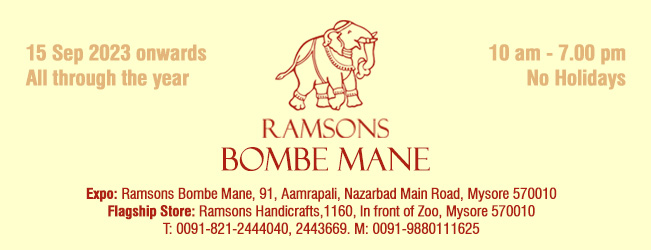They come alive, they sing, they talk, they joke and make you laugh. Do not worry it’s not a gaffe! Looking beautiful, smiling wide, breathing gently and whispering a welcome, they softly tiptoe into your hearts. Each one of them dressed in their finest. This is Bombe Mane and ‘they’ are all dolls. No mystery here; this is the fabled doll festival of Dasara at Mysore.
Go beyond the façade of these dolls, the bright visage frozen in place and eyes that seem to have winked or glanced past you. They have been brought alive with nimble and dextrous fingers of crafts persons across the country.
In keeping with tradition, about ten new dolls have been created at the design wing of Ramsons Kala Pratishtana (RKP) for the tenth edition of ‘Bombe Mane’. The evocative murals of Durga Puja, by late artist Y. Subrahmanya Raju, in the wedding pavilion of Mysore Palace has been created as doll tableaux. Navadurga clay dolls have been fashioned according to the description given in the Sritattvanidhi of Mummadi Krishnaraja Wodeyar. Artist Ravish of RKP converted the Mysore style figures of Sritattvanidhi into line drawings, which were the basis for the Navadurga dolls.
The Navagraha set containing the nine divine planets, according to Hindu cosmology, is fashioned to mimic its original counterpart which can be seen at many temples across south India. A mini model of the Silver Chariot, which is used in various rituals during the Dasara by the royal scion of Mysore, is eager to be part of the doll procession of your own. Ready to join them are the elephant carriage and the famed golden palanquin being drawn by two draught cattle.
Miniature kitchen set in terracotta with quaint rangoli designs and the set of mini puja paraphernalia in gold paint is a doll collector’s favourite. Mini models of Town Hall and St. Philomena’s Church will surely enliven your own Mini-Mysore. Cute birds, animals and hordes of other dolls seem to smile; some gaily tripping, lightly skipping, large and small, flock to mingle and frolic in your home.
Here is a devotee with his precious portable shrine; his foot stomps, his throat growls, his hair twirls and face scowls. This is Jogappa carrying Maaramma or Durgamurgi deity on his head. But then, he is just a doll and this is his customary attitude. Painted tapestries of Phad, Kavad and Kalamkari hangings. These are portable shrines on the move.
The portable shrine is a special feature in this year’s Bombe Mane. While this speaks of an unknown aspect of doll worship, the other section features dolls of various styles of classical dances titled, Dances of India.
Come, walk into the gala land of glittering gudda and guddis and reawaken the child in you.
Dasara is here. Celebrate and rejoice, my dear!



.jpg)

.jpg)











